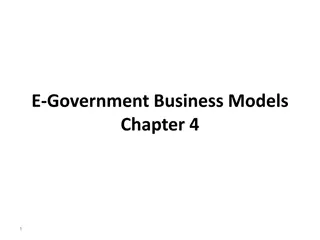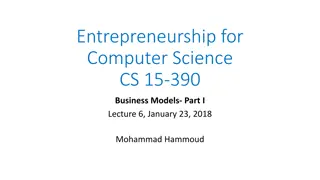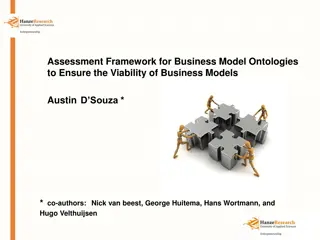Understanding E-Business: Origins, Factors, and Models
The content delves into the origins of e-business transactions, highlighting Electronic Funds Transfer (EFT), Electronic Data Interchange (EDI), and Value-Added Networks (VANs). It also explores unique e-business factors like disintermediation and reintermediation in various industries. Additionally, common e-business models and the essential components required to create and operate an online store are discussed.
Download Presentation

Please find below an Image/Link to download the presentation.
The content on the website is provided AS IS for your information and personal use only. It may not be sold, licensed, or shared on other websites without obtaining consent from the author. Download presentation by click this link. If you encounter any issues during the download, it is possible that the publisher has removed the file from their server.
E N D
Presentation Transcript
7 7 Understanding E-Business Discovering the Internet, 5thEdition
Objectives Describe the origins of electronic business transactions, including the electronic funds transfer (EFT) system, the electronic data interchange (EDI) standard, and value-added networks (VANs) Discuss unique e-business factors and identify e-businesses that use them Chapter 7: Understanding E-Business 2
Objectives Define common e-business models and explain how each model generates revenue Describe the e-retailing storefront software, merchant accounts, and payment-processing services needed to create and operate an online store Chapter 7: Understanding E-Business 3
E-Business Origins Electronic Funds Transfer (EFT) Allows the electronic exchange of money between banks without the exchange of paper currency via the Automated Clearing House (ACH) network Electronic Data Interchange (EDI) Standard that specifies the layout or format a company uses to exchange electronic business data with its suppliers and customers Participants in EDI are called trading partners Before the Internet, used value-added networks (VANs) Chapter 7: Understanding E-Business 4
Unique E-Business Factors Redefining Markets Disintermediation occurs when a market removes its traditional intermediaries Computer industry (Dell) Travel industry Chapter 7: Understanding E-Business 5
Unique E-Business Factors Redefining Markets (continued) Reintermediation occurs when an e-business introduces a new type of intermediary into the marketspace Dell, Hewlett-Packard, and other online versions of stores Orbitz and Hotels.com in the travel industry Chapter 7: Understanding E-Business 6
E-Business Models Chapter 7: Understanding E-Business 7
Creating an Online Store Thousands of men and women become e-business entrepreneurs by starting and operating an online business Famous and successful e-business entrepreneurs Evan Williams (Twitter) Jeff Bezos (Amazon.com) Michael Dell (Dell, Inc.) Reed Hastings (Netflix) Chapter 7: Understanding E-Business 8
Creating an Online Store Storefront Software A typical e-retail transaction consists of several steps Chapter 7: Understanding E-Business 9
Creating an Online Store Storefront Software (continued) Storefront software (also called e-commerce software) provides tools to build and maintain webpages and the underlying product databases Also contains shopping cart software that tracks items selected for purchase and handles the checkout process Summarizing the order Calculating shipping and taxes Calculating the total order Processing the payment Chapter 7: Understanding E-Business 10
Creating an Online Store Storefront Software (continued) Installed storefront software is customizable software that resides on an e-retailer s web server Chapter 7: Understanding E-Business 11
Creating an Online Store Storefront Software (continued) Hosted storefront software uses webpage templates that allow you to create a store and add products to your online catalog May have fees Some vendors provide software demos or allow review of their software on a free trial basis Chapter 7: Understanding E-Business 12
Creating an Online Store Credit Card Authorization and Processing Many online purchases are paid for by credit card Third-party payment processors PayPal Google Wallet An e-retailer that accepts credit cards must have two things Account for credit card receipt deposits Service that authorizes and processes credit card transactions Chapter 7: Understanding E-Business 13
Creating an Online Store Credit Card Authorization and Processing (continued) Merchant account is an e-business account with a financial institution that stores money from credit card purchases Any business that accepts credit cards must have merchant account Can withdraw funds, but only can deposit credit card receipts Chapter 7: Understanding E-Business 14
Creating an Online Store Credit Card Authorization and Processing (continued) Fees might include Setup fees Monthly access fees Per-item transaction fees Discountrate, which is the percentage of each transaction that the financial institution will charge the e- business Chapter 7: Understanding E-Business 15
Creating an Online Store Credit Card Authorization and Processing (continued) Fees for merchant account depend on the financial institution s perceived risk of doing business with the e-business Chargeback return of funds to a credit card company resulting from a card holder s refusal to pay a charge Card not present/card holder not present risk increases the risk of credit card fraud and potential chargebacks Chapter 7: Understanding E-Business 16
Creating an Online Store Credit Card Authorization and Processing (continued) An online store must be able to connect to a payment-processing service that can verify, authorize, and process secure credit card transactions Some vendors offer online payment-processing services, called payment gateways Chapter 7: Understanding E-Business 17
Creating an Online Store Chapter 7: Understanding E-Business 18
Creating an Online Store Credit Card Authorization and Processing (continued) When selecting storefront software, a payment gateway, and merchant account, be certain all three are compatible. Order fulfillment is the process e-retailers have for packaging and shipping products Many e-retailers save time and money by using third- party fulfillment or logistics companies Chapter 7: Understanding E-Business 19
Summary Describe the origins of electronic business transactions, including the electronic funds transfer (EFT) system, the electronic data interchange (EDI) standard, and value-added networks (VANs) Discuss unique e-business factors and identify e-businesses that use them Chapter 7: Understanding E-Business 20
Summary Define common e-business models and explain how each model generates revenue Describe the e-retailing storefront software, merchant accounts, and payment-processing services needed to create and operate an online store Chapter 7: Understanding E-Business 21
7 7 Understanding E-Business Discovering the Internet, 5th Edition























